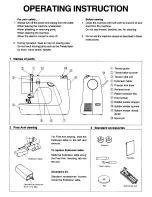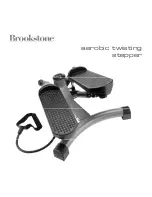
– 8 –
Adjustment Procedure
Results of Improper Adjustment
1. Turn the flywheel until the needle bar
❷
comes to its lowest posi-
tion, and loosen the needle bar connecting setscrew
❶
.
2. Determine the needle bar height.
Adjust the engraved marker line (marker line
A
for the DB needle
and marker line
C
for the DA needle) of the needle bar
❷
to the
lower end of the needle bar lower metal
❸
and tighten the needle
bar connecting setscrew
❶
. (Be careful not to tighten the needle
bar connecting setscrew
❶
too much.)
3. Determine the mounting position of the hook
❻
.
Loosen and turn the three hook setscrews in the direction of
flywheel forward revolutions to raise the needle bar
❷
. In this
direction, adjust the engraved marker line (marker line
B
for the
DB needle and marker line
D
for the DA needle) to the lower end
of the needle bar lower metal
❸
.
4. In this state, adjust the blade point
❺
of the inner hook to the center
of the needle
❹
so that a clearance of 0.04 to 0.1mm (goal value)
is secured between the needle
❹
and the hook
❻
. Since then,
firmly tighten the three hook setscrews.
<Dry hook>
Use the following part number.
The hook part numbers come in two types according to the specifi
-
cations.
22890206 (without the needle guard)
22890404 (with the needle guard)
22890305 (22890206 with special surface treatment)
(Caution) The dry hook (RP hook) tends to collect thread chips
and material dust. This can cause malfunction or de-
fective stitches. Periodic cleaning is required.
<Lubricated hook K: Available separately>
This is a hard blade point hook with a needle holder applicable to
needle size #9 (#65).
Where a thin needle has to be used for reasons of sewing process-
es, this type of hook is applicable to the prevention of stitch skip-
ping and needle breakage.
About the needle bar
Specifications
Part No.
Amount
of looper
return
Needle shank
DDL-8000A*-MS-AA/CC
22886907
1.8mm
ø 1.64
DDL-8000A*-MS-BB
22887004
1.8mm
ø 2.02
DDL-8000A*-SH
(DDL-8000A*-SJ)
40061767
2.3mm
ø 1.64
○ If this clearance is too small, the
blade point of the hook
❻
may be
damaged.
○ Too much clearance may give rise
to stitch skipping.
○ When you use a dry hook, buy and
mount the parts that stop the hook
oil quantity.
Refer to "3.-(7)-5) Adjusting the
amount of oil in the hook".
















































